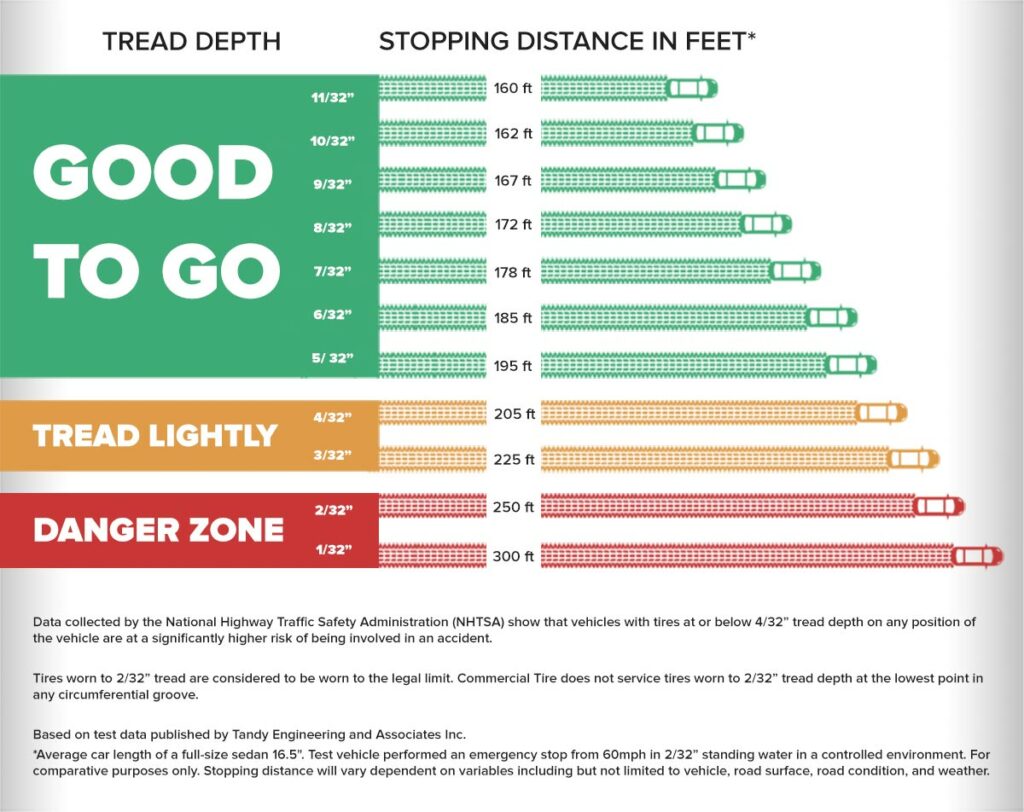You fill your gas tank every week, hit the car wash after it rains, and then get your oil changed every 3,000 miles. But are you giving the same care and attention to your tires?
Your whole tire has a few important components, like the wheel, air pressure, and tire tread. The tread is the rubber that touches the road to provide an appropriate amount of traction. While it might seem like this is a minor aspect of the tire, it makes a big difference in your stopping distance and safety. Here’s how your tire tread depth affects how you can stop quickly and stay safe.
How Your Tread Depth Affects Stopping Distance
Tire tread depth refers to the measurement between your tires’ deepest groove and the top of your tire tread. These grooves allow you to drive over mud, snow, and other debris while keeping contact with the road.
When that tread is worn, it’s like wearing a pair of flip-flops. On a perfect sunny day, they can probably get you from point A to point B, but in poor weather and emergency situations, they won’t provide the necessary safety and protection when you need it most.
For example, if there is excessive water on the road from rain, a worn tire without the deep grooves doesn’t offer a sufficient channel to dispel water, therefore reducing traction and resulting in hydroplaning.
Your tire and your brakes work together to ensure you’re stopping when you need to and as soon as you need to. Keep you and your precious cargo safe by measuring tire depth or getting your tread depth inspected as often as you change your oil.
When You Should Replace Your Tires
While it’s possible to get these tire grooves re-cut in a process called siping, there comes a time when the tires are so worn, there’s no other option than replacing them all together. Many tire manufacturers recommend a tire replacement between 5 to 10 years.
When focusing on the tread, in most cases, brand new tires have tire tread at approximately one third of an inch (10/32 or 11/32 of an inch). Since 1968, the recommended minimum tread depth is 2/32 of an inch. If you are unsure whether your tires are within the safe range of tire tread, check with a tire professional, or you can perform some tricks at home.
Tricks To Measure Your Tread Depth
The Ruler Method
A somewhat self-explanatory way to measure your tread depth is to get out the trusted ruler and simply measure it. Place one end of the ruler in the tread and read off the height on the ruler.
The Penny Test
The perfect measuring tool for your tread depth might be right in your pocket! Insert a penny with Lincoln’s head face first into a tire tread groove. If you can see all of Lincoln’s face, then it is time to get new tires. Measure multiple spots on your tire to check for uneven wear.
When in Doubt, Check It Out
Life can be hectic, but that shouldn’t impede your safety. If you are unsure about the age of your tire and don’t have time to measure your tread, schedule a free safety check at your local Commercial Tire so they can ensure your safety.

